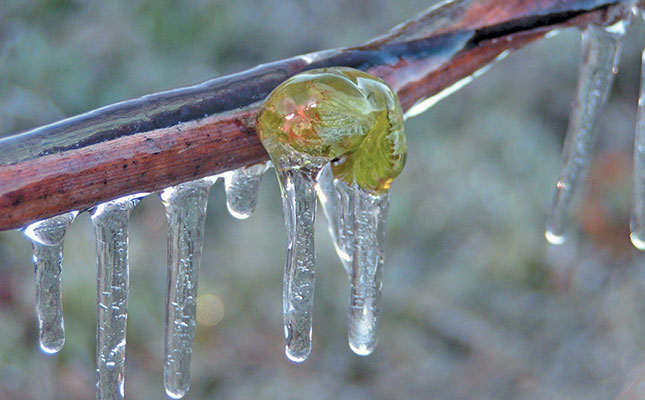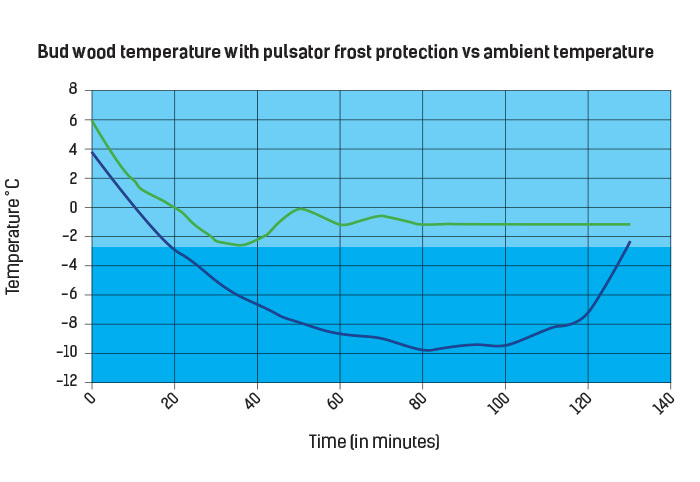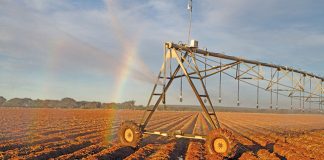
As every farmer knows, black frost can wipe out a crop overnight. Now a new simplified technology designed to protect crops from far more extreme winter conditions than those encountered in South Africa is available here.
Rather than using fuel or electricity to prevent frost damage, it uses latent heat – the heat released when water freezes.
READ Precision farming, new technology and an eye for opportunity
The operating principle is to maintain a thin film of water on the crop. This forms a small igloo around the buds when the temperature reaches freezing point, releasing latent heat that protects the buds against frost damage.
Pure water freezes at 0°C. Plant sap, which contains dissolved compounds in the form of carbohydrates (sugars), freezes when the temperature drops a few degrees lower, which is when frost damage occurs.
During the freezing process, a litre of water dissipates 334 kilojoules (kJ) of latent heat into the surrounding atmosphere, while its temperature remains constant at 0°C.
This released latent heat is the same amount required to melt 1kg of ice into 1ℓ of water, or the amount of heat released by ice when it cools down from 0°C to -163°C! In this way the water ‘insulates’ the plant, ensuring that the sap does not freeze and damage the plant (see graph below).

Pulsator
The technique involves using a pulsator. This applies water at extremely low flow rate – 1ℓ/h to 1,5ℓ/h – which is less than 5% of a microjet’s rate.
The pulsator system is therefore ideal for frost protection, whether in a greenhouse, under shade or outside on the land, if it comes on stream when the temperature drops to near the danger zone (slightly below -2°C for most plants).
Saving water
Pulsators can also promote evaporative cooling and humidification in greenhouses, vineyards and orchard trees during hot summer conditions.
In addition, they can be used to cool chicken pens and animal housing, and protect croplands, vineyards and orchards against sunburn.
A pulsator requires a pressure of 2,5bar to function. It can be connected to any irrigation system operating at this pressure or higher, or to the municipal water supply.
A simple timer and solenoid valve can control the system, but a thermocouple is advised for frost protection. These inexpensive devices can be set to open the system’s solenoid valve when the temperature reaches a certain level.
A pulsator frost protection system also saves a significant amount of water as it can operate over far longer periods than microjets or sprinklers. Moreover, the soil is not saturated and the ground is not flooded.
Keep it cool
On a hot, sunny day in South Africa, a 10m x 30m plastic tunnel can capture more than 10 000 kilowatt-hours (kWh)of heat energy, equivalent to burning 150ℓ of diesel.
If the tunnel is full, the plants use a significant portion of this heat for transpiration. The process of evaporation (wet surfaces or pools of water on the floor) may use some of this heat, but proper ventilation is needed to allow the balance to escape.
READ Be prepared for a “very difficult” winter fire season
If a tunnel or greenhouse is empty and closed, the temperature inside can reach 65°C or higher.
White shading can reduce the heat load entering the greenhouse, but this might not be enough to prevent the temperature from exceeding the desired level plants need for healthy growth.
Traditionally, farmers then resort to installing a wet wall evaporative cooling system.
Less than 4,2kJ of heat energy is required to increase the temperature of a litre of water by 1°C, but almost 2 500kJ (about 600 times more) of latent heat is needed to evaporate it.
Evaporative cooling extracts heat from the air as it enters the greenhouse (or tunnel), causing the water trickling down the special pads or resting on other surfaces to evaporate.
In this way, it can reduce the temperature in a tunnel or greenhouse by 10°C or more, depending on the ambient humidity.
Evaporative cooling works best when the humidity of the outside air is low. It is less effective in high humidity. However, it may not always be necessary to install an expensive wet wall evaporative fan and pad cooling system to keep the plants cool.
Simple options
Before reaching for your wallet, try one or more of the following less costly options:
Take another look at the ventilation.
Where the temperature is likely to increase to 35°C and higher, the area to be opened for ventilation should be the equivalent of at least 25% of the floor area of the greenhouse or tunnel.
Install sprinklers or microjets to intermittently spray small quantities of water onto the roof.
This will decrease the temperature by up to 5°C or more under hot, dry conditions.
Install pulsators to continuously spray water at a very low flow rate over a relatively large area either outside or inside a tunnel, depending on the crop.
Consider installing a low-cost misting system to keep the temperature down. This is standard practice among growers propagating plants from cuttings or seed.
A misting system operates at a very high water pressure, but is excellent for hot, dry conditions.
Email Prof Gert Venter at [email protected]













